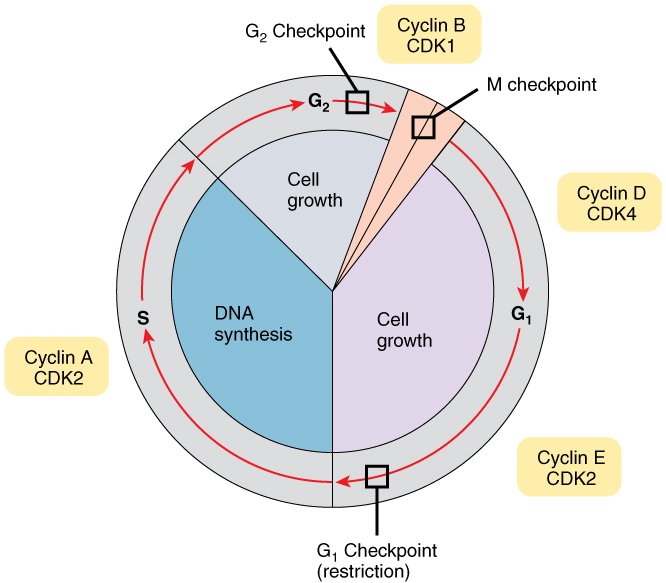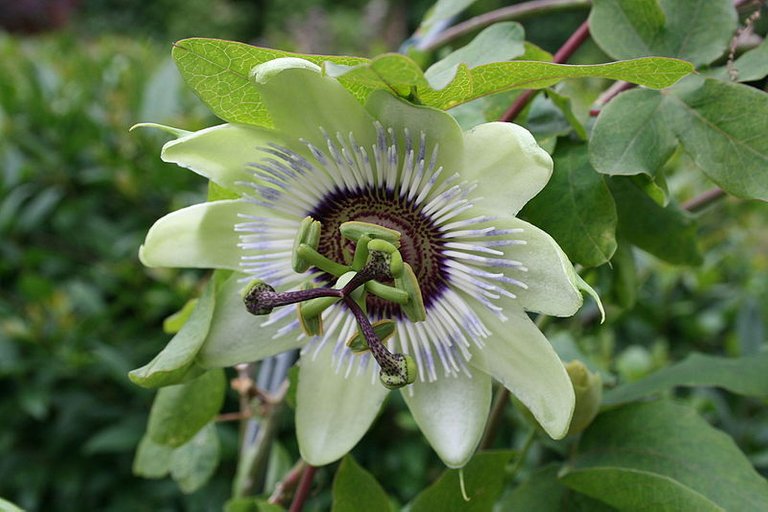Checks and Balances during the Cell Cycle
At the G1 checkpoint, the cell growth is checked and only adequate cell growth/volume would ensure that the cycle continues to the next phase - the S phase. Without adequate growth and development, the cell either tries to correct the anomalies or enters a perpetual resting phase - the G0 phase - until the necessary conditions are given. Some other factors such as the energy reserve and DNA's integrity are also checked before the cell will move on to the next phase and irreversinly commit itself to division.
At the G2 checkpoint, the integrity of the DNA is further scrutinized and chromosome replication at the S phase is checked to ensure the correctness of the process. Cell size and protein reserves are also checked to ensure that things are ok for the cell to move into the mitotic phase. The cell will continously attempt to fix any discovered anomalies before moving on to mitosis.
The M checkpoint is perhaps the most important checkpoint of all the checkpoints in the cell cycle. It happens at the metaphase of mitosis during which chromosomes align at the eqautor of the cell and the spindle fibers connect to each of them at the kienotchore. The connection of the microtubules of the spindle to the kinetochore of each chromosome is checked to ensure their properly connected. Once this is ensured, mitosis can then proceeed.

Why is the M checkpoint the most important?
The M checkpoint is perhaps the most significant of all checkpoints because proper connection of microtubules of the spindle fiber to the kinetochores of chromosomes will ensure that sister chromatids are properly separated and proper separation of chromosomes will ensure that each resulting daughter cell has the correct number of chromosomes in its genome. When chromosomes are not properly seperated and the resulting daughter cells have unsual chromosome numbers, it often has phenotypic implication on the organism. The consequences of unsual chromosome numbers in daughter cells can be aneuplodic or polyploidic.
Aneuploidic conditions
Aneuploidy or aneuplodic condition occur as a result of lack of seperation of sister chromatids during anaphase. This condition is quite dignificant if it happens in meiosis I or II. When a homologous chromosome refuses to separate and meiosis proceeds normally leading to the formation of male or female gametes, the resulting gametes will either have too many (n+1)or too few (n-1) chromosome number.
Now, imagine that a gamete with an extra chromosome (n+1) participates in fertilization with a normal gamete (n), the resulting zygote would have an extra chromosome (2n+1) instead of normal diploid (2n) chromosome. This aneuploidic condition is referred to as trisomy.
If the reverse is the case, that is, a gamete with a chromosome short (n-1) of normal chromosome participates in fertilization with a normal gamete (2n), the resulting zygote will be one chromosome short (2n-1) of the normal diploid chromosome. This aneuploidic condition is referred to as monosomy.
Aneuploidic conditions hardly happen in plants and are also deleterious in animals. A few cases of aneuploidic babies, however, do survive in humans. Cases of survival of trisomic conditions in humans are often reported in males while that of monosomic conditions have often been reported in females. Trisomic conditions constitute Down syndrome in males and Turner syndromes in females. Both conditions have peculiar phenotypic characteristics that make victims to look different from normal diploid humans.

According to Center for Disease Control, the characteristic symptoms of Down syndrome include a flattened face,short neck,small ears, a tongue that tends to stick out of the mouth, tiny white spots on the iris, small hands and feet, a single line across the palm of the hand, small pinky fingers that sometimes curve toward the thumb, poor muscle tone or loose joints, and shorter height. source
On the other hand and according to the National Health Service, the characteristics symptoms of Turner syndrome include swollen hands and feet, shorter height and underdeveloped ovaries, thick neck, characteristic kidney conditions, etc. source
Polyploidic conditions
Sometimes, instead of lack of separation of sister chromatids of a single chromosome at anaphase I or II during meiosis, a complete set of chromosome migrates to a pole, leaving one daughter cell with an extra set of chromosome while the other lacks a chromosome. A zygote that results from the fertilization of a gamete formed from a daughter cell with an extra chromosome and a normal gamete will have an extra set of chromosome above normal. Thus, instead of a normal diploid (2n), triplod (3n), tetraploid (4n), pentaploid (5n), etc. result. This condition is reffered to as polyploidy.
Polyploidic conditions are deleterious in most animals, humans inclusive. However, polyploidic plants do exist and are, most of the time, phenotypically more desirable than normal diploid plants, especially in agriculture. Polyploidic plants generally appear more healthy than diploid/euploidic plants with bigger biomass, flowers, and fruits. Hecence, they are economically more profitable than normal plants.

TL : DR
The cell cylce is regulated in nature by internally controlled processes in order to ensure the integrity of the process. Lack of integrity of the various checkpoints can have serious consequences for the daughter cells that result from the M phase of the cell cycle, especially when it involves the division of the sex cells. Lack of proper separation of chromosomes can result in aneuploidic or polyploidic conditions. Aneuploidic conditions can be deleterious and those that survive among humans often have some phenotypically undesirable features. Polyploidic conditions are deleterious in humans and other animals but are economically more desirable in plants even over the normal diploid plants.
Thank you all for reading.
Thanks for your contribution to the STEMsocial community. Feel free to join us on discord to get to know the rest of us!
Please consider supporting our funding proposal, approving our witness (@stem.witness) or delegating to the @stemsocial account (for some ROI).
Please consider using the STEMsocial app app and including @stemsocial as a beneficiary to get a stronger support.
Congratulations @hadji! You have completed the following achievement on the Hive blockchain and have been rewarded with new badge(s) :
You can view your badges on your board and compare yourself to others in the Ranking
If you no longer want to receive notifications, reply to this comment with the word
STOP